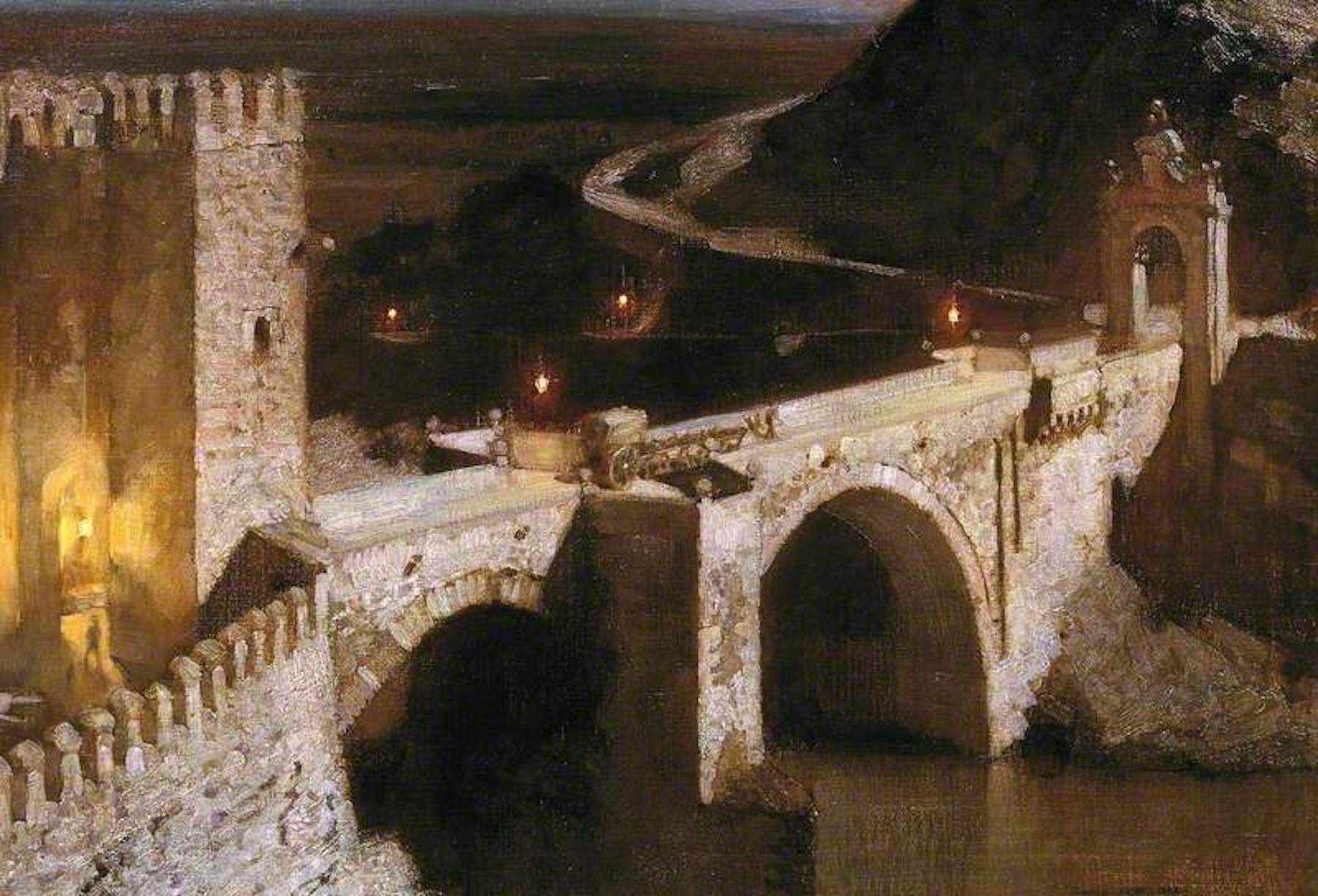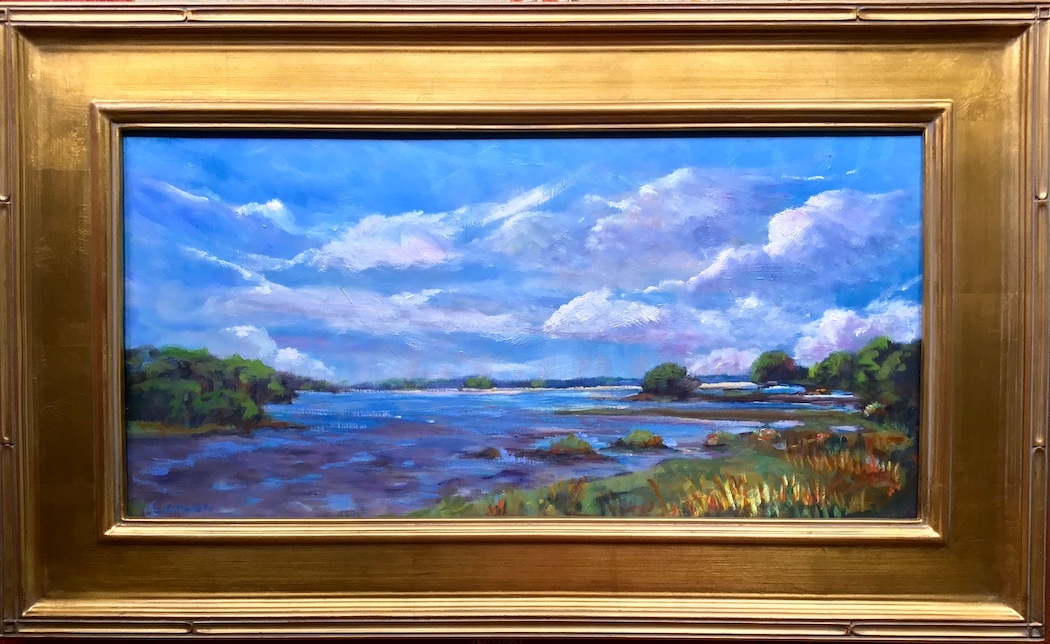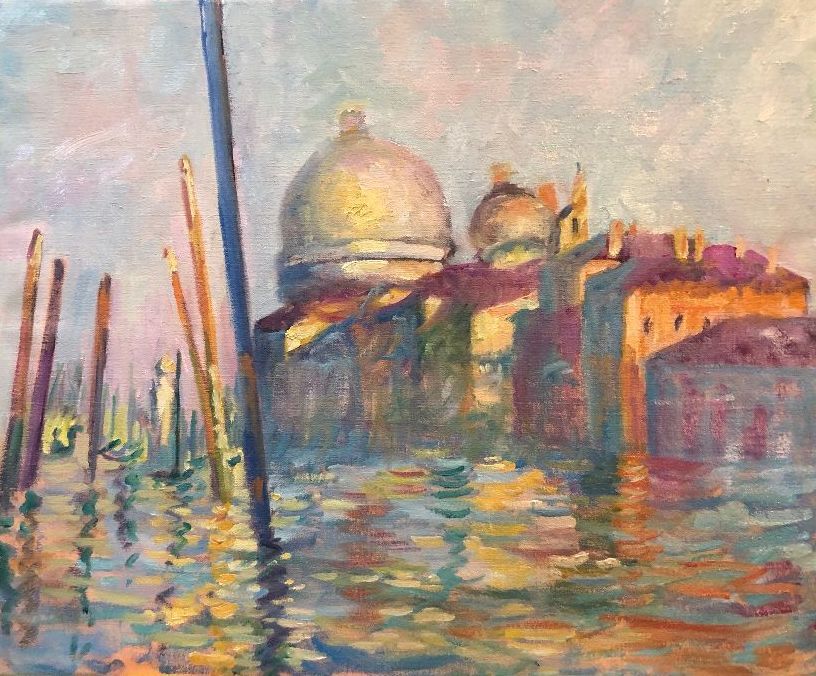Episodes

Monday Jan 21, 2019
Episode 33: Sight and Insight - What does it really mean?
Monday Jan 21, 2019
Monday Jan 21, 2019
Greetings, Art Lovers, we're back!
We had hoped to be back right after the holidays but, unfortunately, a case of the sniffles kept us from getting together to record a podcast. However, everyone seems to be healthy again, so here we are to share some more thoughts with you about all things Art.
Today, our theme is Sight and Insight. It is the name of our podcast, as well as the idea behind David and Connie's workshops to help students take it to the next level.
“It is this perfect accuracy, this lack of play, of variety, that makes the machine-made article so lifeless. Wherever there is life there is variety, and the substitution of the machine-made for the hand-made article has impoverished the world to a greater extent than we are probably yet aware of. Whereas formerly, before the advent of machinery, the commonest article you could pick up had a life and warmth which gave it individual interest, now everything is turned out to such a perfection of deadness that one is driven to pick up and collect, in sheer desperation, the commonest rubbish still surviving from the earlier period.” ― Harold Speed, The Practice and Science of Drawing
So how do we, as artists, get more sight, and insight, into our work? We can study some of the great artists and teachers of bygone days.

Harold Speed, The Alcantara, Toledo, by Moonlight, 1894, Tate Britain, UK
David brings his years of experience as an artist and teacher to help with ways of 'seeing,' while our resident psychologist/artist, Connie, gives us some insight into what the word means in terms of the creative process.

Harold Speed, Old Tom, oil on canvas. 63.9 x 51 cm, Southampton City Art Gallery, UK, presented by the artist, 1930, #545
Can't get enough of us? Then look for our next episode two weeks from now. Yes, sorry about that. We know you like your weekly dose of the Sight and Insight Podcast, but various commitments in the upcoming weeks mean it is going to be hard for us to get together as often as we'd like.
Until then, stay warm and happy painting.
Connie, David and Judy
"There is nothing so terrible as activity without insight." — Johann Wolfgang von Goethe

Tuesday Dec 11, 2018
Episode 32 - Can you paint an effect of Light?
Tuesday Dec 11, 2018
Tuesday Dec 11, 2018


"The sky is the source of light in Nature and it governs everything." – John Constable

John Constable, Dedham Lock and Mill, c. 1818, oc 27 1/2 x 35 3/4 Private collection
Join Connie, David and Judy as they consider the question, "Can you paint an effect of light?" Obviously our two resident artists, David and Connie - as plein air painters - believe that is the whole point of American Impressionism and painting on location, is to capture that rare moment in time: an effect of light.
It is the prime motive for any artist wanting to work out of doors direct from nature. Judy waxes lyrical on the attributes of Leeds painter Atkinson Grimshaw, while Constable and Sorolla are also held up as masters of the light effect.

Atkinson Grimshaw, Park Row, Leeds 1882, oc 30 x 25 Leeds City Art Gallery

Atkinson Grimshaw, Scarborough by Moonlight, c 1876, ob 11 x 17. Private collection
"Light is a thing that cannot be reproduced, but must be represented by something else – by color." – Paul Cezanne
David poses the question, does movement represent light, or space? How do you create the optical illusion of an effect of light with color, brush and canvas? What do you think?
Of course, when it comes right down to it, perhaps the best purveyor of of Light is the Spanish Master, Sorolla and so we will leave the last word, or rather image, to him....

Joaquin Sorolla y Bastida, The Carob Tree, 1898, oc 19 3/4 x 38 1/2. Private collection

Monday Dec 03, 2018
Episode 31: Gestalt!
Monday Dec 03, 2018
Monday Dec 03, 2018
Have you got your Gestalt on?!
"There's something happening here. What it is ain't exactly clear." Buffalo Springfield
Join Connie, David and Judy as they explore the idea of Gestalt; what it means and how it can help the artist create a better painting.
One of the great masters of Gestalt was Johannes Vermeer, who - as early as the 17th-century knew that a composition - or its properties, should be viewed as a whole. Variety within unity is the idea.

Johannes Vermeer (Dutch, 1632 – 1675) The Astronomer, c. 1668, oil on canvas, 20 x 18, Musee du Louvre, Paris
Gestalt is a German word meaning form, or shape, and Gestalt theory in terms of art refers to the concept of perception, holding that the whole is more than the sum of its parts.
As human beings, we tend to try and organize our perceptions of a chaotic world. Thus as artists we can utilize several principles of gestalt to improve our painting:
1. Figure-ground - this refers to relationships between an object and its surroundings. Do we see the figure in front of us, or the background?
2. Closure - it is important to keep the viewer involved by completing an image or form. The principle of closure applies when we tend to see complete figures even when part of the information is missing.
3. Continuance - the viewer has a tendency to follow a path, river, beach, fence line, etc. These compositional elements give the viewer numerous ways to enter, and move around a painting.
4. Similarity - things which share visual characteristics such as shape, size, color, texture, or value will be seen as belonging together in the viewer’s mind.
5. Proximity - The Gestalt law of proximity states "objects or shapes that are close to one another appear to form groups." Even if the shapes, sizes, and objects are radically different, they will appear as a group if they are close together.
As our resident psychologist explains it is possible to suffer from proximity flow, then we can lose the 3rd dimensional depth, leaving us with only 2 dimensions, which means our painting is all of one plane with no depth of field.
Think about your own painting compositions. Do you achieve 'variety within unity?' If not, it sounds like your gestalt needs tweaking. Tune in to learn more from David, Connie, and Judy.
"A cloudy sky to make it mysterious and a fog to increase the mystery. Just imagine how suggestive things are..." John H. Twachtman



Tuesday Nov 20, 2018
Episode 30 Jane Peterson
Tuesday Nov 20, 2018
Tuesday Nov 20, 2018
Episode 30 Jane Peterson: Artist Extraordinaire
“Sex has nothing to do with it at all. Art is one activity where being a woman is neither a help nor a hindrance. Even a woman’s intuition means nothing when she is facing a canvas.” - Jane Peterson
[quoted in J. Jonathan Joseph, Jane Peterson, An American Artist (Boston, 1981): 43. This is the primary source for biographical information on Peterson. For information on The Group see Jarzombek, “Mary Bradish Titcomb and her Contemporaries” in Mary Bradish Titcomb (1858-1927) / Fenway Studios (Boston: Vose, 1998).

Jane Peterson, Gloucester Harbor, oc, 30 x 40, private collection (Sold at auction for $520k in 2005, after estimated between $250,000-$350,000)
Artist Jane Peterson (1876-1965) was active in Massachusetts, New York, Kansas, IL., as well as Europe and North Africa. Born Jennie Christine in Elgin, IL., she changed her name (at the age of 33) to Jane Peterson; a name that now resonates through the art world as a talented and skillful artist of the finest caliber. She studied with some of the best-known instructors of the day, including Arthur Wesley Dow and Frank Vincent DuMond in New York, as well as with Frank Brangwyn in Venice and England. In addition, she learned from the master himself, Joaquin Sorolla y Bastida in Madrid. From Sorolla she learned to lighten her palette and heighten her chroma, while also painting rapidly to capture the fleeting effect of light.
Like many women artists, Peterson went into teaching, becoming the Drawing Supervisor of the Brooklyn Public Schools. She continued to travel and paint as circumstances allowed, frequently working in North African countries such as Algeria and Egypt, until the outbreak of World War I. However, as soon as an Armistice was declared she resumed her travels, sojourning even farther afield in 1924, when she spent six months in Turkey, exploring Constantinople (Istanbul) and Broosa (Bursa), a daring and audacious undertaking for a woman voyaging alone.

Jane Peterson, Afternoon at the Market, c. 1910, oc, 24 x 30, private collection
Peterson was adept in oil painting, watercolor and gouache, which - being a quick drying medium - was highly practical for a traveling artist.
She has been called an Impressionist, and an Expressionist as well as an Abstractionist, but Jane Peterson is not one to have her talents curtailed by a pigeonhole. She painted what she wanted, where she wanted and, in the recent Strokes of Genius: Women Artists of New England exhibition at the Rockport Art Association and Museum, it was obvious she could work in many styles, with each painting presenting a unique appearance and finish.
Often described as a 'vigorous realist,' who favored luscious color and bravura brushwork, perhaps the final word on Peterson's work should go to the critic of the Christian Science Monitor who, reviewing her solo show at Boston's St. Botolph Club on January 23, 1909, was moved to admit, “There is an athletic dash and swing to most of the paintings that is stimulating and captivating.” [quoted in Joseph, p. 27]
Captivating, indeed, and none more so than Peterson's oil paintings of Gloucester Harbor, Cape Ann.

Jane Peterson, An Old Pier, Gloucester, c. 1919, oc, 24 x 30, private collection
And on a final note:
Connie will be hosting an Open House at her studio, the weekend after Thanksgiving. Consider this your invitation....

Lorwen, Forsythia, oil, 24 x 20
Thanksgiving Weekend Open Studios
Lorwen ‘Connie’ Nagle invites you to see her latest paintings on November 24 & 25, 10am-5 pm, at Art On The Hill, 78 Government Street, Kittery, Maine

Monday Nov 12, 2018
Episode 29: Nature's Magnetism
Monday Nov 12, 2018
Monday Nov 12, 2018
Greetings, Art Lovers, and welcome to another edition of the Sight & Insight Podcast.
Well, as we all know Nature is very magnetic, and we aren't just talking about magnetic fields, from one pole to the other, repelling and attracting, but the strong draw that Nature, the great outdoors, exudes toward the plein air painter.

George Inness (1825-1894) Lake Nemi, 1872, oc 29 3/4 x 44 7/8 in. Museum of Fine Arts, Boston, Gift of the Misses Hersey, 49.412
As that great artist, Aristotle, was heard to say, "In all things of Nature, there is something of the marvelous. Whether we are looking at the awe inspiring works of Frederic Edwin Church, who opened the eyes of the public to the great expansion of the American West - sights some Americans would never see for themselves - or the subtleties of nature portrayed by, say, George Inness, Nature exudes an allure - a captivatingness, that can mesmerize us. As Harold Speed once pointed out, trees in nature are much bigger than the imagination conjures up. From the macrocosm to the microcosm, Nature is all around us, seductive and enchanting, whether in a sprawling vista, or the urban grittiness of humanity's effect on the land.

Frederic Edwin Church (1826-1900) Niagara Falls, from the American Side, 1867, oc, 101 3/8 x 100 13/16 in. Scottish National Gallery, Presented by John S. Kennedy, 1887, NG799
"Dwell on the beauty of life. Watch the stars, and see yourself running with them. — Marcus Aurelius

Monday Nov 05, 2018
Episode 28 Is it Drawing First?
Monday Nov 05, 2018
Monday Nov 05, 2018
Greetings, art lovers, and welcome to another episode of the Sight & Insight Podcast with David and Judy Curtis, and Lorwen 'Connie' Nagle. This week we ask 'Is it Drawing or Painting First?
"Drawing is the artist's most direct and spontaneous expression, a species of writing: it reveals, better than does painting, his true personality." — Edgar Degas
In the beginning, Judy relates an anecdote about Boston painter, Polly Thayer Starr, who was talented from her childhood with graphite and charcoal. She spent her first year at the Boston Museum School studying anatomy and life drawing with Philip Leslie Hale, but when she began painting in her second year with Leslie Thompson, she found herself adrift, unable to understand the texture, viscosity and application of color and paint.
 Polly Thayer Starr, Sketching
Polly Thayer Starr, Sketching

Polly Thayer Starr, Flat Cat
David and Connie, as practicing artists and teachers have their own viewpoints on the subject and, for once, they differ in opinion. Will they come to blows, or agree to disagree? Is it different for individual students. Does drawing ability even matter? Join our intrepid trio to to hear what they have to say. And if you have other thoughts, don't hesitate to let them know! They always love to hear from fans....


Note how French Neoclassical painter Jean-Auguste-Dominique Ingres (1780-1867) made drawings before beginning to paint a larger work.
Left: Ingres, Preparatory drawing; graphite and white highlights on paper, 1842.
Right: Ingres, Portrait of Comtesse d'Haussonville, 1845, 51.89 x 35.83 in. The Frick Collection, New York
So what do you think? Is drawing with a brush too awkward? Can you paint a landscape, or still life, or interior, without a sense of perspective? Perhaps, as Cezanne says, we need a sense of both drawing and painting.
"Drawing and colour are not separate at all; in so far as you paint, you draw. The more the colour harmonizes, the more exact the drawing becomes." — Paul Cezanne
Don't forget to click the follow button, so you can be a part of the group. Connie, Judy and David love to know you are out there.

Monday Oct 29, 2018
Episode 27 The Element of Surprise
Monday Oct 29, 2018
Monday Oct 29, 2018
"Surprise is key in all art." — Oscar Niemeyer
The Element of Surprise!
Did you miss us?! We hope so. You know what they say - absence makes the heart grow fonder! But we've finished our travels for a while and we are back around the coffee table sharing ideas, encouraging an interest in the Arts and, hopefully, inspiring you to go out and paint for yourself.

John Singer Sargent, Dolce Far Niente, c 1907, o/c 16.25 x 28.25 in. Brooklyn Museum, NY
Today we are talking about the element of surprise, or 'the happy accident.' From John Singer Sargent to Bob Ross, the ability to take the odd note, or mis-stroke and turn it into an integral part of your design - an element you perhaps hadn't thought of before - is a vital part of the creative process. So shake off the entropy, get out of autopilot, and let your creative juices run....


Giovanni Boldini (1842-1931) Left: Spanish Dancer at the Moulin Rouge, c. 1905, oil on canvas, 49 ¼ x 40 ⅛, pc Right: Woman at the Piano, 1870, oil on panel, 6 x 5 ⅛, pc.
Just look how Boldini uses semi abstract brush work in the beginning from which 'happy accidents' he draws out the reality of his subject. Critics described his his style as 'slashing, rapier-like brushstrokes.'
If you have enjoyed this episode, don't forget to join us next week for another edition of the Sight & Insight Podcast with Connie Nagle, David Curtis and Judith Curtis. In the meantime, why not hit the Follow button and help us to greater heights for the good of Art.
"In art, the hand can never execute anything higher than the heart can imagine." — Ralph Waldo Emerson



Monday Oct 01, 2018
Episode 26: Sight and Insight Programs
Monday Oct 01, 2018
Monday Oct 01, 2018
"You will learn to enjoy the process... and to surrender your need to control the result. You will discover the joy of practising your creativity. The process, not the product, will become your focus." — Julia Cameron


Welcome art lovers, to another edition of the Sight and Insight podcast. Today’s topic: the Sight and Insight programs.
Judy begins off topic with an introduction into the insight of ’21 in Truro,’ a women’s painting group who exhibit together throughout the year and enjoy a retreat for a week down in Truro, sharing five rustic cottages right on the marsh, or as close to as you can get!

These 21 women are all individual artists who have been getting together for the last 20 years – next year is their 21stanniversary – and they only need another seven years to catch up with the Philadelphia Ten. The Philly Ten were an early women’s group, which included Theresa Bernstein and Emma Fordyce MacRae, who got together to empower women’s art at a time when many women signed their paintings with initials to disguise their gender from painting juries.
The discussion then comes round to David and Connie’s upcoming ‘October Skies’ workshop, October 10-12, as they talk about some of the ideas they will be bringing to their students, such as the ‘line of design,’ the advantage of memory cards, and how beauty and aesthetics are affect a painting.

You want to know how to get more movement and drama in your skies? Stay tuned for more words of wisdom from Connie and David!

Lorwen C Nagle, Mud Flats near Brunswick, 12 x 24, oil
"The search for this inner truth is the search for beauty. People whose vision does not penetrate beyond the narrow limits of the commonplace, and to whom a cabbage is but a vulgar vegetable, are surprised if they see a beautiful picture painted of one, and say that the artist has idealised it, meaning that he has consciously altered its appearance on some idealistic formula; whereas he has probably only honestly given expression to a truer, deeper vision than they had been aware of. The commonplace is not the true, but only the shallow, view of things." — Harold Speed, The Practice and Science of Drawing

Sunday Sep 23, 2018
Episode 25: Don Stone - Doing It His Way
Sunday Sep 23, 2018
Sunday Sep 23, 2018


Greetings, Art Lovers, and thank you for joining us for another exciting episode of the Sight and Insight Podcast. Today we are talking about a great show currently on exhibit at the North Shore Arts Association, 11 Pirates Lane, Gloucester, MA 01930. Don Stone Comes Home is on view through October 9 and features over 140 works.

Bittersweet by Don Stone
Don Stone could turn his hand to oil painting, watercolors, egg tempera and more and these skills, combined with an unerring eye for composition and design, helped him become a noted artist and beloved teacher during a long and successful career. Our intrepid trio discuss Don's work, his larger than life personality and the character quirks that made him a legend in his own lifetime!


Winter Trees Barn Rafter with Swallows
And if you get chance, join Judy and David Curtis, and hopefully, Lorwen, at Judy's presentation on Don Stone at the North Shore Arts Association, 2 pm, Sunday, September 30.
Happy listening!

Tuesday Sep 18, 2018
Episode 24: Copying the Masters
Tuesday Sep 18, 2018
Tuesday Sep 18, 2018
Welcome to another edition of the Sight and Insight Podcast. This week, our intrepid trio, David, Connie and Judy, willbe discussing the weighty topic of copying from the masters.
Is it sneaky, as some people think, or cheating; or is it an age old method of learning to paint better by studying closely, and emulating the work of, old masters who have stood the test of time?
During today's episode, Connie relates the tale of how she finally managed to get access to the Museum of Fine Arts in Boston to copy Monet's Grand Canal. This is her version below. She also made a copy of Antonio Cirino's Peonies from the Rockport Art Association and Museum's Copying the Masters Workshop earlier this year.


As Connie says, it is important to see how a past master has designed and created their work of art, especially their color tones and brushwork. Studying these elements can only make your own work better.
While on his Paige Traveling Scholarship in Europe, in 1913, A. T. Hibbard - as a graduate art student from the School of the Museum of Fine Arts, Boston, was admitted to the Museo del Parado in Madrid to copy from Velazquez, including Las Hilanderas (The Weavers) below.

Of course, the criteria for copying another's creation is that it should not be sight size. In Hibbard's case, he did a large painting of the lower right hand side of the painting. Hibbard's version is now a part of the RAA&M's Permanent Collection.
There are many reasons for practicing copying from the masters, not least of which is improving your own art. David teaches an annual workshop at the RAA&M, so if you want to try improving your art by this method, keep checking David's website at davidpcurtis.com for more details.
In the meantime, if you would like to view Connie and David's upcoming exhibition, Three With a Brush, with their painting friend, Tom Heinsohn, check out the invitation below. Or view Connie's website at lorwenpaintings.com for further details.

And don't forget, David and Connie are teaching a Sight and Insight workshop, October Skies, October 10-12, 2018.
Want to know how to paint better skies with movement and drama? Then check David and Connie's websites for further information on how to sign up. Still a few places available. Don't lose out!
And, last but not least, if you have enjoyed this podcast, don't forget to hit the red follow button, so you don't miss out on another episode.
Have a great week!
Connie, David and Judy
PS. Next week we will be talking about the current Don Stone: Coming Home Exhibition at the North Shore Arts Association, 11 Pirates Lane, Gloucester, MA 01930 Ph. 978.283.1857 or email: arts@nsarts.org
This is a great exhibition containing over 100 paintings. Judy will also be giving a presentation on Don Stone and his work on Sunday, September 30 at 2 pm. Come along and join the fun.



